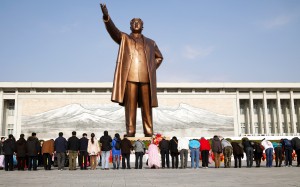Kaesong with other 19 historic sites inscribed on UNESCO World Heritage

Sok An, deputy prime minister of Cambodia and chairman of the 37th Session of the World Heritage Committee (WHC), remarks during the closing ceremony of the 37th Session of the World Heritage Committee (WHC), in Siem Reap, Cambodia, on June 27, 2013. Two Chinese properties and 17 other places around the globe were inscribed on the World Heritage List during the WHC's 37th annual session, bringing the total number of world heritage sites to 981. (Photo : Xinhua/Li Ying)
The 37th Session of the UNESCO World Heritage Committee came to an end successfully on Thursday after 11 days in action.
Addressing the closing ceremony held in the tourism city of Siem Reap province on Thursday night, Cambodian Deputy Prime Minister Sok An, chairman of the session, expressed the country’s pride to host such an important meeting.
“During the session, our work was intense, constructive, inspiring and enriching in the spirit of solidarity, cooperation and tolerance,” Sok An said at the event which was attended by delegates of the 21-member World Heritage Committee. “Now, it comes to an end successfully.”
He also congratulated Qatar for hosting the 38th Session of the World Heritage Committee next year. Alissandra Cummins, President of the Executive Board of UNESCO, lauded Cambodia for successfully hosting the event.
“From this session, it is evident that Cambodia will continue to play a vital role in advancing the mandate of the organization in the area of cultural heritage,” she said.
The 37th Session of the World Heritage Committee was held in capital Phnom Penh on June 16. Over the period of 11 days, the session had inscribed 19 new heritage properties around the globe on the UNESCO’s World Heritage List, bringing the total number of World Heritage Sites in the world to 981.
The sites are recognized by the UNESCO for their exceptional beauty or cultural value.
The 19 newly-listed sites included two Chinese new sites: Xinjiang Tianshan natural property and Cultural Landscape of Honghe Hani Rice Terraces, two Italian sites: Mount Etna and Medici Villas and Gardens, Mexico’s El Pinacate and Gran Desierto de Altar Biosphere Reserve, Namibia’ s Namib Sand Sea, Tajikistan’ s Tajik National Park, Canada’s Red Bay Basque Whaling Station, Historic Monuments and Sites in Kaesong of the Democratic People’s Republic of Korea, Fiji’s Levuka Historical Port Town, India’s Hill Forts of Rajasthan, Iran’s Golestan Palace, Ukraine’s Ancient City of Tauric Chersonese, Japan’s Fujisan, Niger’s Historic Centre of Agadez, Wooden Tserkvas of the Carpathian Region in Poland and Ukraine, Portugal’ s University of Coimbra, Qatar’s Al Zubarah Archaeological Site, and Germany’s Bergpark Wilhelmshoehe.

Kishore Rao, director of the World Heritage Centre, remarks during the closing ceremony of the 37th Session of the World Heritage Committee (WHC), in Siem Reap, Cambodia, on June 27, 2013. (Photo : Xinhua/Li Ying)
Besides, the committee added six World Heritage sites in Syria on the List of World Heritage in Danger due to the country’s civil war that caused heavy damage to the sites.
The six sites in Syria are Ancient City of Damascus, Ancient city of Bosra, Site of Palmyra, Ancient City of Aleppo, Crac des Chevaliers and Qal’at Salah El-Din, and Ancient Villages of Northern Syria.
Moreover, it placed the World Heritage site of East Rennell in Solomon Islands to the List of World Heritage in Danger due to logging that is affecting the ecosystem of the site, while the World Heritage site of Bam and its Cultural Landscape in Iran, struck by a major earthquake, were removed from the List of World Heritage in Danger.
Ek Tha, a spokesman for the 37th session of the World Heritage Committee, said that all discussions during the session had been made in a frank manner and friendly atmosphere.
“Cambodia is very proud to chair this UN committee smoothly and professionally,” he told Xinhua. “Through this milestone event, Cambodia will be more known to the outside world — as we all know over 1,460 delegates from 128 countries have joined this meeting.” <Xinhua/NEWSis>



















































